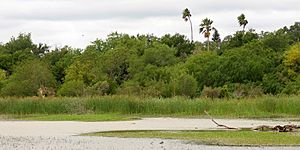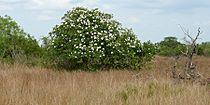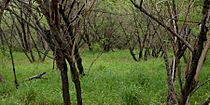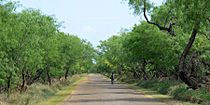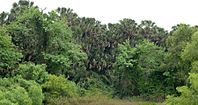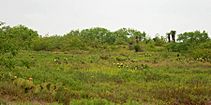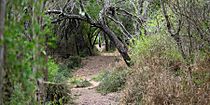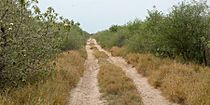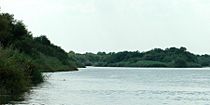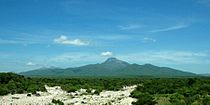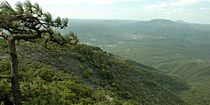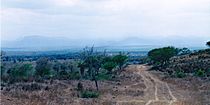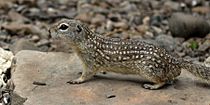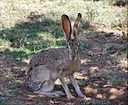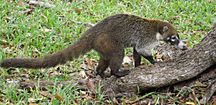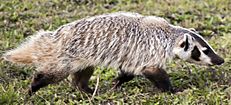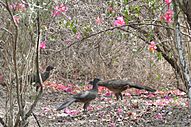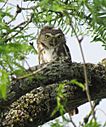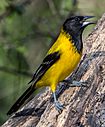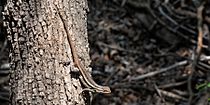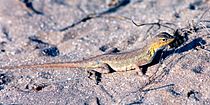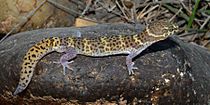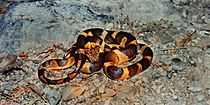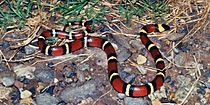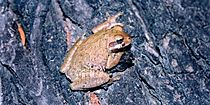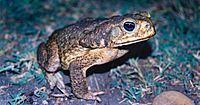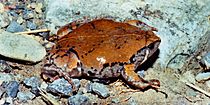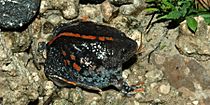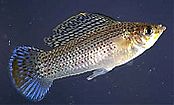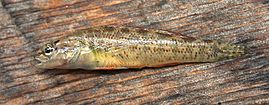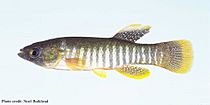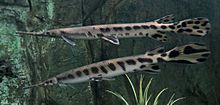Tamaulipan mezquital facts for kids
Quick facts for kids Tamaulipan mezquital |
|
|---|---|

Tamaulipan thornscrub, Webb County, Texas, USA (10 June 2016)
|
|
 |
|
| Ecology | |
| Realm | Nearctic |
| Biome | Deserts and xeric shrublands |
| Borders |
List
|
| Bird species | 340 |
| Mammal species | 90 |
| Geography | |
| Area | 141,500 km2 (54,600 sq mi) |
| Countries | Mexico and United States |
| States | Coahuila, Nuevo Leon, Tamaulipas and Texas |
| Rivers | Rio Grande |
| Conservation | |
| Habitat loss | 18.449% |
| Protected | 0.68% |
The Tamaulipan mezquital (called Mezquital Tamaulipeco in Spanish) is a special kind of ecoregion in the southern United States and northeastern Mexico. It's known for its dry lands and tough shrubs, which are called deserts and xeric shrublands.
This large area covers about 141,500 square kilometers (54,600 square miles). You can find it in parts of southern Texas, northern Tamaulipas, northeastern Coahuila, and Nuevo León.
Contents
Where is the Tamaulipan Mezquital?
This ecoregion is bordered by different natural areas. To the west, the Sierra Madre Oriental mountains separate it from the drier Chihuahuan Desert.
The Tamaulipan matorral is a transition zone. It lies between the mezquital and the Sierra Madre Oriental pine–oak forests to the west. It also connects to the Veracruz moist forests in the south.
Along the Gulf of Mexico, you'll find the Western Gulf coastal grasslands. These are known as the Tamaulipan pastizal in Mexico. To the north are the Edwards Plateau savannas. The East Central Texas forests and Texas Blackland Prairies are to the northeast.
Land and Water Features

A natural ridge called the Bordas Escarpment cuts through this region. East of this ridge, the land is flat with deep, sandy soils. Many areas here have been turned into farms.
West of the Bordas Escarpment, the land becomes gently rolling hills. The soil is thin and has a lot of calcium, sitting over a thick layer of caliche (a hardened natural cement). This western part is great for ranching and wildlife, but not as good for farming.
Rocks and Mountains
The region has layers of limestone, sandstone, siltstone, and claystone rocks. These layers gently slope towards the sea. The land is usually from sea level up to 300 meters (about 980 feet) high.
Some small mountain ranges are found here, like the Sierra de San Carlos. These mountains are different from the main Sierra Madre Oriental range. They were formed by igneous rock (volcanic rock) pushing up from underground.
Coastal Sand Plains
The Coastal Sand Plain is also known as the "Wild Horse Desert." It's a sandy area stretching about 60 miles inland from the Laguna Madre. The sand can be six feet deep in many places, with dunes reaching 30 feet high.
This area is mostly flat, but the sand often forms dunes and low areas called swales. Grasslands cover much of the sand plain. You'll also see groves of live oak trees and smaller groups of honey mesquite trees. Many temporary ponds form here after rain.
Rivers and Wetlands
Even though the region is semi-arid (mostly dry), it has many wetlands. The Laguna Madre is a very salty lagoon, one of only five like it in the world. It's a vital ecosystem located between the Gulf of Mexico and the mezquital.
Closer to land from the lagoon, you'll find freshwater marshes. These marshes change with rainfall and tropical storms. When they are full, they can be very large. They support salamanders, turtles, and millions of migrating waterfowl like redheads in winter.
Several rivers flow through the region, all heading east to the Gulf of Mexico. These rivers have created many oxbow lakes, resacas (old river channels), and marshes. The areas along these rivers, called riparian zones, can have lush tropical jungle plants if they haven't been cleared for farms or cities.
Important rivers include the San Antonio River, Nueces River, and the Rio Grande (also called Rio Bravo in Mexico). Other rivers are the Rio Salado, Rio San Juan, Rio San Fernando, and Rio Soto La Marina.
Man-made Lakes
Many large lakes in the region were built after World War II. These include Choke Canyon Reservoir and Lake Corpus Christi in the U.S. On the Rio Grande, you'll find Amistad International Reservoir and Falcon International Reservoir. In Mexico, there are Presa Venustiano Carranza, Presa El Cuchillo, Presa Marte R. Gómez, and Presa Vicente Guerrero.
Tamaulipan Mezquital Gallery
-
Grasslands with Wild Olive (Cordia boissieri), Jim Hogg County, Texas, USA (10 April 2016)
-
Bentsen-Rio Grande Valley State Park, Hidalgo County, Texas, USA (15 April 2016)
-
Trail through mature thornscrub forest in Santa Ana National Wildlife Refuge, Hidalgo County, Texas, USA (14 April 2016).
-
Sierra San Carlos, Municipality of San Carlos, Tamaulipas, Mexico (14 July 2007)
-
Sierra San Carlos, with a pine tree (Pinus teocote) on left, Municipality of San Carlos, Tamaulipas, Mexico (12 July 2007)
Plants of the Tamaulipan Mezquital
This dry region is mostly covered by "Mezquital," which means a mesquite grove in Spanish. It's full of thorny bushes and chaparral plants, known as Tamaulipan thornscrub. Because it's a subtropical area, some plants grow almost all year.
The plants here can change a lot depending on if it's a dry year or a wet year with tropical storms. Thornscrub grows taller and thicker near the coast where there's more moisture. In drier inland areas, it's often shorter and more spread out.
Common Plants
Many plants are found almost everywhere in this region. These include honey mesquite (Prosopis glandulosa), spiny hackberry (Celtis ehrenbergiana), desert Christmas cholla (Cylindropuntia leptocaulis), Texas persimmon (Diospyros texana), Texas prickly pear (Opuntia engelmannii var. lindheimeri), and black brush (Vachellia rigidula).
Other common trees and shrubs, often found on clay soils, are white bush (Aloysia gratissima), goat bush (Castela erecta), brasil (Condalia hookeri), and knackaway (Ehretia anacua).
Grasslands and Woodlands
Grasslands with scattered trees grow on flat or gently rolling sandy areas. They are mostly covered by dense grasses like Texas grama (Bouteloua rigidiseta) and little bluestem (Schizachyrium scoparium). Wildflowers like bull-nettle (Cnidoscolus texanus) also grow here.
Woodlands have a well-developed tree canopy over a layer of grasses. Taller grasses like hooded windmill grass (Chloris cucullata) grow with shorter ones like grama (Bouteloua spp.). Some areas have thick stands of Texas prickly pear instead of grasses.
Rocky Uplands
Xeric rocky uplands are dry, rocky areas with shallow soils over caliche and gravel. They support shrubs that are one to two meters tall. You'll find plants like cenizo (Leucophyllum frutescens), guajillo (Acacia berlandieri), and Spanish dagger (Yucca treculeana). The creosote bush (Larrea tridentata) grows in the western parts.
Salty Areas
Saline lakes and saline thornscrub are found in low-lying areas where water collects and evaporates, leaving salt behind. These lakebeds are often dry or have salt-loving grasses like alkali sacaton (Sporobolus airoides). The surrounding thornscrub has common shrubs and special plants like saladillo (Varilla texana).
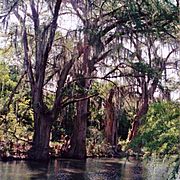
Riverbank Forests
Riparian zones and floodplains along the major rivers can have lush forests. These forests can have a dense canopy up to 15 meters (about 50 feet) high. Common trees include granjeno (Celtis ehrenbergiana), sugar hackberry (Celtis laevigata), Texas ebony (Ebenopsis ebano), and Mexican ash (Fraxinus berlandierana).
Vines and air plants like Spanish moss (Tillandsia usneoides) are common. In the Nueces River area, pecan (Carya illinoinensis) and plateau live oak (Quercus fusiformis) are often seen.
The Rio Grande Delta has a denser understory with smaller trees like Sierra Madre torchwood (Amyris madrensis) and Barbados cherry (Malpighia glabra). Huge Montezuma cypresses (Taxodium mucronatum) once lined the rivers, but few remain. Small groves of Mexican sabal palm (Sabal mexicana) are also found on the Rio Grande Delta.
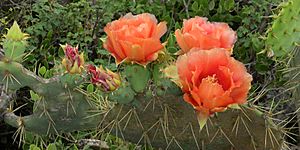
Cacti Diversity
This region has many different types of cacti. Besides common ones like lace cactus (Echinocactus reichenbachii) and horse-crippler cactus (Echinocactus texensis), you can find unique species.
Some examples include triangle or barbed wire cactus (Acanthocereus tetragonus), star cactus (Astrophytum asterias), and peyote (Lophophora williamsii). Some cacti, like Astrophytum caput-medusae from Nuevo Leon, Mexico, are found only in this region.
Animals of the Tamaulipan Mezquital
This area is home to many different animals, from large mammals to tiny fish.
Mammals of the Mezquital
The region once had many large meat-eating animals. However, most became very rare or disappeared by the mid-1900s. The gray wolf (Canis lupus) is gone from here. Black bears (Ursus americanus) are now mostly found in the Sierra de Picachos in Nuevo León.
Jaguars (Panthera onca) were last seen in Texas in the 1950s, but a few might still exist in Mexico. Similarly, jaguarondi (Herpailurus yaguarondi), ocelot (Leopardus pardalis), and margay (Leopardus wiedii) are endangered in the U.S. and Mexico.
Some mountain lions (Puma concolor), White-nosed coatis (Nasua narica), and American Badgers (Taxidea taxus) still live here. Other common mammals include raccoons (Procyon lotor), coyotes (Canis latrans), and bobcats (Lynx rufus).
Other mammals you might see are the collared peccary (Pecari tajacu), white-tailed deer (Odocoileus virginianus), and nine-banded armadillo (Dasypus novemcinctus). Bats like the Mexican long-tongued bat (Choeronycteris mexicana) also live here. Rodents include the Mexican prairie dog (Cynomys mexicanus) and Rio Grande ground squirrel (Ictidomys parvidens).
-
Collared peccary (Pecari tajacu), Hidalgo Co. Texas (4 Feb 2010).
-
Black-tailed jackrabbit (Lepus californicus), Texas (13 June 2006).
-
Ocelot (Leopardus pardalis) with tracking caller, Laguna Atascosa National Wildlife Refuge, Cameron Co. Texas.
-
Mexican long-tongued bat (Choeronycteris mexicana).
-
White-nosed coati (Nasua narica), Mexico (5 Sept 2009).
-
American badger (Taxidea taxus), Marin Co., California (25 Nov 2007).
Birds of the Mezquital
The southern part of this ecoregion is a special area for birds. It's home to unique species like the red-crowned amazon (Amazona viridigenalis), Tamaulipas crow (Corvus imparatus), and long-billed thrasher (Toxostoma longirostre).
Other birds found here include the white-tailed hawk (Buteo albicaudatus), plain chachalaca (Ortalis vetula), and green parakeet (Psittacara holochlorus). You can also see tropical birds like the green jay (Cyanocorax yncas), Ferruginous pygmy owl (Glaucidium brasilianum), and great kiskadee (Pitangus sulphuratus).
-
Plain chachalaca (Ortalis vetula), Municipality of Montemorelos, Nuevo León (9 April 2009).
-
Red-crowned Amazon (Amazona viridigenalis), Cameron Co. Texas (15 Mar 2016).
-
Ferruginous pygmy owl (Glaucidium brasilianum), King Ranch, TX (15 Mar 2016).
-
Buff-bellied hummingbird (Amazilia yucatanensis), Sabal Palm Sanctuary, Cameron Co. Texas (21 Sept. 2015).
-
Great kiskadee (Pitangus sulphuratus). Bee Co., Texas (3 July 2011).
-
Long-billed thrasher (Toxostoma longirostre), Texas, USA (20 Feb. 2017).
-
Audubon's oriole (Icterus graduacauda), Starr Co. Texas (1 Feb 2014).
Reptiles of the Mezquital
The American alligator (Alligator mississippiensis) lives in the northern part of this region. The Morelet's crocodile (Crocodylus moreletii) is found in the south.
Many turtles also live here, such as the red-eared slider (Trachemys scripta), Mexican box turtle (Terrapene mexicana), and Texas tortoise (Gopherus berlandieri). The Texas tortoise's home range almost perfectly matches the Tamaulipan mezquital.
Unique lizards include the Laredo striped whiptail (Aspidoscelis laredoensis). These are all-female lizards that reproduce without a male, a process called parthenogenesis. The reticulate collared lizard (Crotaphytus reticulatus) is also found only here.
Other lizards include the Texas banded gecko (Coleonyx brevis), four-lined skink (Plestiodon tetragrammus), and Texas horned lizard (Phrynosoma cornutum).
Snakes like the Tamaulipan hook-nose snake (Ficimia streckeri) and Mexican milksnake (Lampropeltis annulata) are found here. Common snakes include the gopher snake (Pituophis catenifer) and long-nose snake (Rhinocheilus lecontei).
Venomous snakes in the region are the Texas coralsnake (Micrurus tener) and western diamond-back rattlesnake (Crotalus atrox).
-
Rose-bellied lizard (Sceloporus variabilis marmoratus), Hidalgo County, Texas, USA (14 April 2016).
-
Keeled earless lizard (Holbrookia propinqua), municipality of Soto La Marina, Tamaulipas, Mexico (20 May 2002).
-
Texas banded gecko (Coleonyx brevis), Webb County Texas, USA (10 June 2016).
-
Texas Tortoise (Gopherus berlandieri), northern Tamaulipas, Mexico (9 July 2007).
-
Northern cat-eyed snake (Leptodeira septentrionalis), Municipality of Victoria, Tamaulipas, Mexico (7 Aug 2003).
-
Mexican milksnake (Lampropeltis annulata), Municipality of Victoria, Tamaulipas (30 Oct 2003).
-
Western diamondback rattlesnake (Crotalus atrox), Municipality of Padilla, Tamaulipas, Mexico (29 May 2004).
Amphibians of the Mezquital
Even though it's a dry area, there are enough wetlands to support amphibians. Salamanders like the black-spotted newt (Notophthalmus meridionalis) and the lesser siren (Siren intermedia) live here.
Frogs and toads are also common. The Rio Grande leopard frog (Lithobates berlandieri) and western narrow-mouthed toad (Gastrophryne olivacea) are found in the region. Toads like the green toad (Anaxyrus debilis), Texas toad (Anaxyrus speciosus), and cane toad (Rhinella horribilis) also live in the thorn scrub and grasslands.
Many tropical species reach their northern limits here. These include the Mexican treefrog (Smilisca baudinii) and the unusual burrowing toad (Rhinophrynus dorsalis).
-
Mexican Treefrog (Smilisca baudinii), Municipality of Abasolo, Tamaulipas, Mexico (18 May 2002).
-
White-lipped Frog (Leptodactylus fragilis) Municipality of Victoria, Tamaulipas, Mexico (12 August 2003).
-
Couch's Spadefoot (Scaphiopus couchii), Cameron County, Texas, USA (11 April 2016).
-
Black-spotted Newt (Notophthalmus meridionalis), Santa Ana NWR, Hidalgo Co, Texas (14 April 2016).
-
Sheep Frog (Hypopachus variolosus), Municipality of Victoria, Tamaulipas, Mex (12 August 2003).
-
Burrowing Toad (Rhinophrynus dorsalis), Municipality of Reynosa, Tamaulipas, Mexico (8 October 2007).
Fish of the Mezquital
Two fish species are found only in this region: the San Ignacio pupfish (Cyprinodon bobmilleri) and the swordtail platyfish (Xiphophourus xiphidium). The Amazon molly (Poecilia formosa) is an all-female species that reproduces without a male, a process called gynogenesis.
Other fish in the area include the alligator gar (Atractosteus spatula), longnose gar (Lepisosteus osseus), and Rio Grande cichlid (Herichthys cyanoguttatus). Sadly, two species that were only found here, the phantom shiner (Notropis orca) and the Salado shiner (Notropis saladonis), are now believed to be extinct.
-
Sailfin molly (Poecilia latipinna)
-
Gulf killifish (Fundulus grandis), male, Dixie Co., Florida.
-
Rio Grande silvery minnow (Hybognathus amarus)
-
Rio Grande cichlid (Herichthys cyanoguttatus), Texas
-
Longnose gar (Lepisosteus osseus)
-
Alligator gar (Atractosteus spatula)
Protecting the Tamaulipan Mezquital
Many nature preserves exist in this region, especially on the north side of the Lower Rio Grande Valley. The state of Texas manages several parks and wildlife areas here. These include Lake Casa Blanca International State Park, Falcon State Park, Bentsen-Rio Grande Valley State Park, Estero Llano Grande State Park, and Resaca de la Palma State Park.
The U.S. Federal Government also protects lands like the Santa Ana National Wildlife Refuge and parts of the Laguna Atascosa National Wildlife Refuge. The Lower Rio Grande Valley National Wildlife Refuge has almost 40,000 acres open to the public. The Sabal Palm Sanctuary is also important, preserving old riparian zones and sabal palm groves.
Outside the Lower Rio Grande Valley, protected lands include the Chaparral Wildlife Management Area and Lake Corpus Christi State Park.
In Tamaulipas, Mexico, protected areas include parts of Laguna Madre y Delta del Rio Bravo. In Coahuila, Mexico, there's Parque Nacional Los Novillos. Many protected areas in Mexico are managed by local communities. While they may not have visitor facilities, they still help limit development and protect the habitat, plants, and animals.


